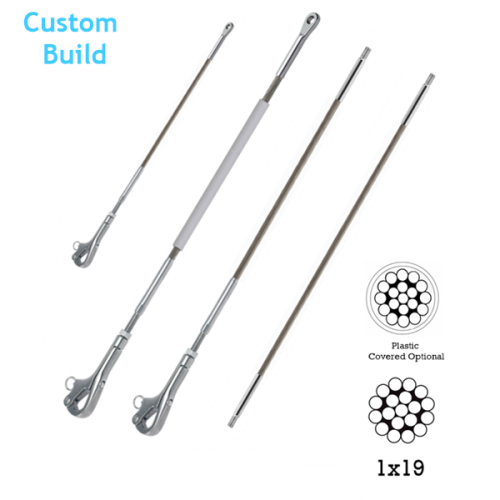

GRAB A BARGAIN - 15% off Running Rigging and Rodkickers until 31 December 2025
Say something...
Nothing found. Please repeat.
Unsupported browser. Sorry...


Click on the buttons below to build your replacement guard rails, or select 'None' for the Upper/Lower Termination if you just need a length of cut wire.
If you need any advice or would prefer to talk to one of our rigging experts about your requirements, please get in touch. Before you start, make sure you know the lengths of your guard wires, as shown in the example below, or if you prefer, send us your existing guard wires, and we can use that as a template.


Our Delivery Policy

Returning Your Order - Our policy
1x19 Stainless Steel Wire Standing Rigging is a great choice for this purpose. It is commonly used throughout the yachting world, and you can now configure and purchase the guard wires you need on our website. Here at Martin Leaning Masts & Rigging, we use KOS 1x19 stainless steel wire. Here's why it is a great choice. In our opinion, it's the world's best wire, and our terminals are from premium world-recognised brands, and all rigging is professionally terminated with meticulous care.
See the guide to using our Guard Wire Custom Build Calculator.
| Diameter | Breaking Strain (kg) |
|---|---|
| 5mm | 2000 |
| 6mm | 2880 |
KOS Stainless Steel Wire Rope manufactured using 316 marine grade stainless steel to 1.4401 is recognised throughout the world for its superior quality and has an outstanding reputation for suitability in a marine environment
This 316 marine grade 1×19 stainless steel cable construction is the most popular as it is suitable for all types of general applications due to its low elasticity and high braking load.
Guard Rail Wires, also known as lifelines, are a crucial safety feature on yachts. They provide a protective barrier along the deck to prevent crew members from falling overboard. Proper maintenance ensures guard rail wires remain reliable and safe, while understanding common issues helps prevent failures at sea.
Guard rail wires are typically made from stainless steel wire, coated wire, or synthetic rope, and are supported by stanchions along the yacht’s deck. They are tensioned to provide a secure barrier while allowing some flexibility for movement.
Stainless Steel Wire: Most durable and corrosion-resistant but requires regular inspection.
Coated Wire: Offers additional protection against saltwater but can hide internal deterioration.
Synthetic Rope: Lightweight and adaptable but may degrade faster under UV exposure.
Regular maintenance prolongs the lifespan of guard wires and enhances safety. Follow these steps to ensure their reliability:
Check guard wires frequently for signs of wear, corrosion, or damage.
Look for frayed strands, cracks in coated wire, or loose fittings.
Ensure stanchions are firmly attached to the deck.
Wash guard wires with freshwater regularly to remove salt deposits.
Apply marine-grade lubricant to fittings and terminals to prevent corrosion.
If using coated wire, inspect for cracks where water might penetrate and cause internal rusting.
Guard wires should have the correct tension—too loose, and they become ineffective; too tight, and they may stress fittings.
Inspect turnbuckles and end fittings for corrosion or wear.
Replace worn or compromised fittings before failure occurs.
Synthetic guard wires should be checked for UV degradation.
Cover exposed sections with protective sleeves if necessary.
Replace older synthetic ropes that have signs of brittleness or weakening.
Saltwater exposure accelerates corrosion, especially in stainless steel wires. Regular cleaning and inspection help mitigate rust buildup.
Over time, metal wires can weaken and snap, compromising safety. If frayed strands appear, replace the guard wire immediately.
Plastic-coated wire can crack, allowing moisture to seep in, leading to hidden corrosion. Avoid excessive bending, and replace degraded coated wires.
Stanchions can loosen due to repeated stress or impact. Check their bases for movement and ensure deck fittings remain secure.
Guard wires need to be properly tensioned. Over-tightened wires can stress fittings, while overly loose lines may not provide adequate support.
Guard Wire Inspection and Replacement Made Simple
Properly maintained guard wires enhance the safety of a yacht’s crew. Regular inspections, timely replacements, and correct tensioning ensure they remain reliable in all conditions. By understanding common issues and addressing them promptly, sailors can navigate with confidence knowing their guard wires are up to the task.
Boxed:
Sticky Header:
Sticky Add To Cart
Sticky Footer:
Font:

